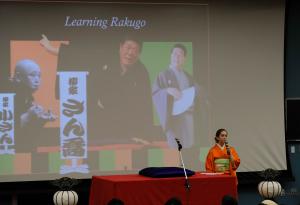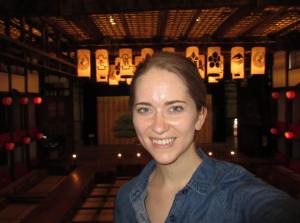CEAS Faculty Spotlight: Melissa Van Wyk
PUBLISHED ON APRIL 3, 2023
Melissa Van Wyk’s work is broadly invested in the intersection between scientific forms of knowledge and the stage in premodern Japan, especially the confluence of medical discourses about the body, attitudes toward and experiences of wonder, and moments where printed media, theater, and street performance illuminate the theatrical nature of public discourses of knowledge. These interests lead Professor Van Wyk to the study of misemono (見世物, みせもの) spectacle shows in early modern Japan and their longstanding mutual relationship with kabuki (歌舞伎, かぶき - a classical form of Japanese theatre, mixing dramatic performance with traditional dance). Situating kabuki within a broader and more diverse performance landscape, one made up not only of established theaters, but street acrobatics, misemono, exhibitions, newspaper selling, and variety shows, has remained a central focus of her work.
In her first project, “Restaging the Spectacular: Misemono and Kabuki Theater 1700–1900,” Professor Van Wyk explored these ideas by attending to kabuki’s spectacular elements—its aerial tricks, large-scale mechanics, prosthetic technologies, etc.—and to how the material practices of the theater inflected its engagement with concepts of encyclopedic knowledge, technologies of time, and the extraordinary body. While primarily focused on the stage, the project also strives to explore the ways in which spectacle can – and historically has – critiqued regimes of knowledge or authority while also interrogating how spectacle has simultaneously been complicit in the production and reinforcement of constructions of the normal by sensationalizing the strange or unusual through exhibition and display.
This project was initially inspired by materials Professor Van Wyk encountered during a visit to the Yokohama Archives of History while researching the history of theater in Yokohama and studying at the Inter-University Center for Japanese Language Studies (IUC) in 2014-2015. Embedded within news reports of a rapidly developing Yokohama and its heterogenous performance scene of local theaters, kabuki actors from nearby Tokyo, foreign circuses, and Shakespeare productions, were newspaper records of a performance by kabuki actor Sawamura Tanosuke III in Yokohama in 1867, dedicated to American doctor James Curtis Hepburn, who had performed amputation surgery on Tanosuke’s leg the year before. The sensationalized nature of the public’s fascination with the medical spectacle of Tanosuke’s surgery and prosthetics, occurring within larger shifts in definitions of the body, disability, and gender in the early Meiji period, motivated Professor Van Wyk to consider the larger history of kabuki’s stage spectacles and how kabuki could serve as a public space for exploration of and negotiation with these discourses.
Professor Van Wyk’s second project on “true crime” and infamy in early modern Japan builds on these ideas to examine the concepts of criminality and infamy and their uneven application in early modern Japan. Part of a longstanding interest in the complex mixing of documentary, fictionality, and theatricality found in the consumption of narratives based on actual events and figures on stage and page, the project uses the circulation of printed single-sheet newspaper (瓦版, かわらばん, kawaraban) to frame her study of news, sensationalism, scandal, and criminality in early modern performance culture. In addition to these two book manuscripts, Professor Van Wyk is pursuing projects on the performance of Dutch-language plays in Dejima in 1820 and Japanese translations of the plays, and on the cultural impact and career of onnagata (女形/女方 - male actor in kabuki who plays female roles) Nakamura Utaemon VI.
Professor Van Wyk’s teaching at the University of Chicago has provided her a productive opportunity to share and explore these interests with her students; she has taught undergraduate and graduate courses on “True Crime and Infamy in Early Modern Japan” and “Sense and Sensation in Premodern Japanese Theater and Literature.” An avid reader of modern Japanese literature as well, she has also designed a course that pairs works of classical and modern Japanese theater and fiction to explore the internal and external dynamics of recollection, alienation and inheritance, shifting perceptions of orality in literature, and explorations of alternative possibilities in the remembrance (and misremembrance) of classical literature and theater. Professor Van Wyk is also looking forward to teaching Classical Japanese and a reading course in Japanese premodern theater texts during the 2023-2024 academic year.
Melissa Van Wyk is Assistant Professor in Japanese Literature at the University of Chicago.
Read more about the CEAS Faculty Spotlight series.
 THE UNIVERSITY OF CHICAGO
THE UNIVERSITY OF CHICAGO



